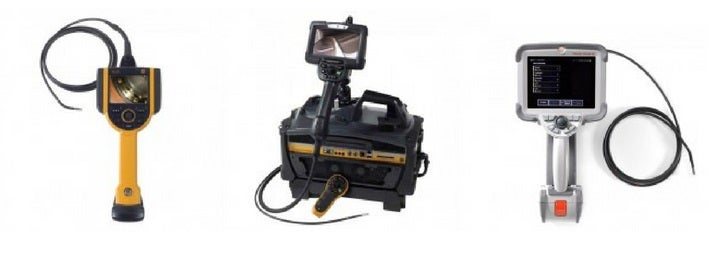
Borescopes are widely used in many different industrial and commercial applications, enabling real-time remote-visual internal inspection inside cylindrical cavities, voids, confined spaces, pipes and closed structures using high-quality images or video.
There are many different types of borescope on the market, which vary in terms of length, diameter and functionality. When choosing a borescope, these are some of the features that you should consider: articulation, portability, weight, power source, illumination, still or video capture function, optics and image quality, water-resistance and data capture capabilities.
Your selection should be made according to your specific requirements, but decision-making can be tricky. The following top five FAQs about borescopes may be useful in helping you decide how your operation can benefit from the technology and which type is best-suited to your particular application.
What’s the difference between a rigid borescope, a fibrescope and a videoscope?
A rigid borescope is a rigid optical instrument similar to a telescope and can only access areas that can be viewed in a direct, straight line. These have limited applications but they do deliver very clear, high-resolution images. This technology was the precursor to the fibrescope, which relies on fibre optics to transmit remote images. Fibrescopes are flexible and can be articulated (meaning that the viewing end of the insertion tube is ‘steerable’ and can be pointed in any direction). It should be noted however, that borescopes and fibrescopes are not all of equal quality or functionality and can vary significantly in terms of their accuracy, reliability, image quality, image capture capabilities, size of entry point, ability to negotiate angles etc.
Videoscopes are a fairly recent development in remote visual inspection (RVI) camera technology and are growing in popularity due to their superior resolution, illumination and ease-of-use. They differ mechanically from fibrescopes in that they have a tiny video camera and lights on the far end of the insertion tube, which captures images and transmits them electronically to a video processor and display monitor.
How important is articulation?
Articulation is an extremely useful feature, enabling operators to insert the camera into the inspection area and move it around for a full 3600 viewing. Articulation is typically required when there are bends and turns to be negotiated and when the inspection area is at an angle.
Can a borescope be used to transmit video imaging?
Yes, many models of borescope and fibrescopes can be linked to video devices as long as there is sufficient illumination. Video imaging adds a significant level of flexibility and functionality to the devices enabling technicians to collaborate with colleagues in real-time, make comparisons, share inspection results or archive them for future reference. A videoscope produces images of higher resolution and magnification.
What factors need to be considered before choosing a borescope?
To determine which borescope is most appropriate for your needs, you need to consider a range of factors including the length needed to reach the area of inspection, the diameter of the space that the borescope needs to pass through, desired image quality resolution, whether articulation is required, whether bends have to be negotiated to reach the inspection area, what light source is needed, battery life, the desired level of control, budget considerations and the operating environment (temperatures, humidity etc).
Is renting a borescope a viable option?
Renting is certainly a viable option when it comes to remote visual inspection equipment as you don’t have to make any upfront capital investment plus you have the flexibility to adjust your rental equipment to meet your changing needs. And however tempting low-end models at seemingly bargain prices are, it’s never a good idea to compromise on quality. It’s worthwhile discussing your borescope rental or purchase options with a reputable supplier who can make sound recommendations based on your particular needs and their industry experience.
One such supplier is Nexxis, an Australian-owned company which offers an extensive array of technologically advanced yet durable borescopes and videoscopes suitable for a wide range of applications.

